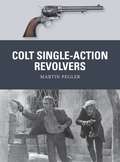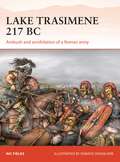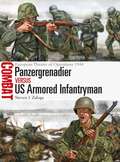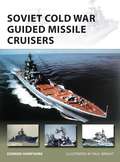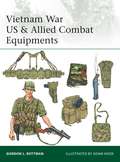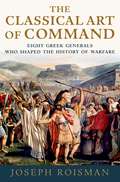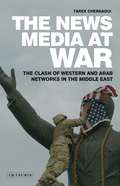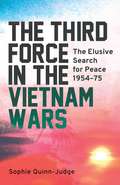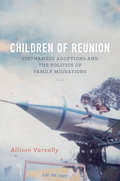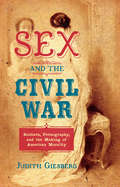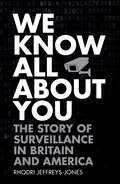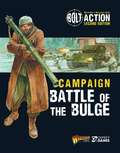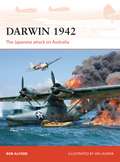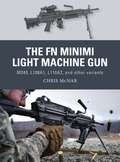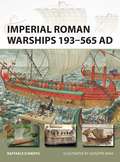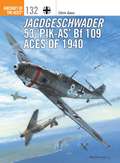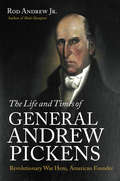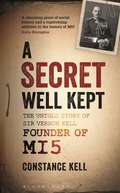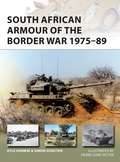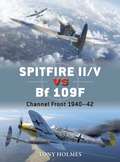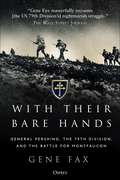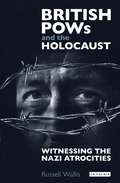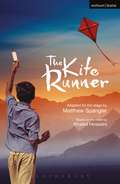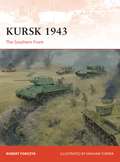- Table View
- List View
Colt Single-Action Revolvers (Weapon)
by Martin Pegler Mark Stacey Alan GillilandIn 1836, Samuel Colt changed the face of warfare with the production of the first of a series of iconic and influential single-action revolvers, including the .44-calibre Colt Walker and the seminal .45-calibre Colt Single Action Army, which remains in production today. These weapons shifted the role of the pistol from single-shot weapon of last resort to a practical and powerful sidearm that gave the user the ability to defend himself once his primary armament was discharged. It transformed cavalry tactics and relegated the sword to a largely ceremonial role in many armies.Featuring full-colour artwork, expert analysis and gripping first-hand accounts, this is the absorbing story of Colt's family of single-action revolvers, covering their origins, development, use and lasting impact on the modern world.
Lake Trasimene 217 BC: Ambush and annihilation of a Roman army (Campaign #303)
by Nic Fields Donato SpedaliereFollowing Hannibal's crushing victory at the battle of the Trebbia, the reeling Roman Republic sent a new army under the over-confident consul Caius Flaminius to destroy the Carthaginian invaders – unbeknownst to him they were ready and waiting. The destruction of the Roman force at Lake Trasimene firmly established Hannibal as one of the Ancient World's greatest commanders thanks to his use of innovative tactics, including the first recorded use of a turning movement. The Romans would not send another major army to confront him until the battle of Cannae in 216 BC. This new study, based on recent archaeological work on the battlefield itself, tells the full story of one of Hannibal's greatest victories with the help of maps, full-colour illustrations, and detailed sections on the make-up of the armies and their commanders.
Panzergrenadier vs US Armored Infantryman: European Theater of Operations 1944 (Combat #22)
by Steven J. Zaloga Johnny ShumateDuring World War II, the two pre-eminent mechanized infantry forces of the conflict, the German Panzergrenadier arm and the US Army's armoured infantrymen, clashed in France and Belgium after the Normandy landings. These engagements went on to profoundly influence the use of mechanized infantry in the post-war world. Drawing upon a variety of sources, this book focuses on three key encounters between July and December 1944 including during Operation Cobra and the Battle of the Bulge, and examines the origins, equipment, doctrine and combat record of both forces.With specially commissioned full-colour artwork and maps, this study sheds light on the evolving nature of mechanized warfare at the height of World War II.
Soviet Cold War Guided Missile Cruisers (New Vanguard)
by Paul Wright Edward HampshireHeavily armed and formidable, guided missile cruisers formed the core of the Soviet Navy during the Cold War. From the last class of conventional Sverdlov-class cruisers through to increasingly complex and formidable missile cruisers, these ships ensured that NATO took the Soviet naval threat seriously. Soviet Cold War Guided Missile Cruisers covers all classes of these impressive warships, from the early Sverdlov through the Kynda, Kresta, Kara and Slava to the enormous Kirov classes. Together, these vessels marked the apogee of Soviet naval technology and capability and they remain today the largest non-aircraft carrier warships built since 1945. Containing material previously only available in Russian and fully researched from specialist defence journals, this comprehensive volume examines the design, development, and intended role of these impressive, hi-tech warships, and recounts their dramatic operational history as NATO and Soviet warships faced off against each other during the long Cold War at sea.
Vietnam War US & Allied Combat Equipments (Elite)
by Adam Hook Gordon L. RottmanOver the eight years of the Vietnam War, US forces used three major types of equipment sets, with numerous modifications for particular circumstances. Different equipments were also used by Special Forces, the South Vietnamese, and other allied ground troops.Vietnam War US & Allied Combat Equipments offers a comprehensive examination of the gear that US and allied soldiers had strapped around their bodies, what they contained, and what those items were used for. Fully illustrated with photographs and artwork detailing how each piece of equipment was used and written by a Special Forces veteran of the conflict, this book will fascinate enthusiasts of military equipment and will be an ideal reference guide for re-enactors, modellers and collectors of Vietnam War memorabilia.
The Classical Art of Command: Eight Greek Generals Who Shaped the History of Warfare
by Joseph RoismanThe Classical Age of Greece produced some of history's best-known generals and commanders. They include the Spartan king Leonidas, who embodied his countrymen's heroic ethos in the battle of Thermopylae; the Athenian leader Themistocles, credited as the architect of Athens' naval power and of the Greek victory over the Persians; the famous democratic leader, Pericles, who prepared Athens and directed its conflict with Sparta, known as the Peloponnesian War; the Athenian general Demosthenes, who deviated from contemporary conventions of warfare with his innovative approach; the Spartan general Lysander, who won the Peloponnesian War for Sparta; Dionysius I of Syracuse, arguably the most innovative and best skilled of the eight generals discussed in this book; and Epaminondas and Pelopidas who together transformed their city, Thebes, into an hegemonic power. The Classical Art of Command gives readers a unique opportunity to examine the variegated nature of Greek generalship through the individual careers of eight prominent commanders. It describes the attributes of these leaders' command, the many facets of their individual careers and stratagems, and the mark they left on Greek history and warfare. It draws attention to the important role that personality played in their leadership. Joseph Roisman investigates how these generals designed and executed military campaigns and strategy, and to what degree they were responsible for the results. The volume also looks at how the Greek art of command changed during the Classical Age, and how adaptable it was to different military challenges. Other questions involve the extent to which a general was a mere leader of the charge, a battle director, or a strategist, and what made both ancient and modern authorities regard these eight generals as outstanding shapers of military history. Filled with original analyses and accessible accounts of legendary battles, The Classical Art of Command will appeal to all readers with an interest in ancient warfare and generalship.
The News Media At War: The Clash of Western and Arab Networks in the Middle East
by Tarek CherkaouiTarek Cherkaoui reveals how geo-political and ideological legacies of the past, which divide the world into a dichotomy of 'us' against 'them', play a dominant role in reinforcing the ensuing polarisation of our media.
The Third Force in the Vietnam War: The Elusive Search for Peace 1954-75
by Sophie Quinn-JudgeIt was the conflict that shocked America and the world, but the struggle for peace is central to the history of the Vietnam War. Rejecting the idea that war between Hanoi and the US was inevitable, the author traces North Vietnam's programs for a peaceful reunification of their nation from the 1954 Geneva negotiations up to the final collapse of the Saigon government in 1975. She also examines the ways that groups and personalities in South Vietnam responded by crafting their own peace proposals, in the hope that the Vietnamese people could solve their disagreements by engaging in talks without outside interference. While most of the writing on peacemaking during the Vietnam War concerns high-level international diplomacy, Sophie Quinn-Judge reminds us of the courageous efforts of southern Vietnamese, including Buddhists, Catholics, students and citizens, to escape the unprecedented destruction that the US war brought to their people. The author contends that US policymakers showed little regard for the attitudes of the South Vietnamese population when they took over the war effort in 1964 and sent in their own troops to fight it in 1965.A unique contribution of this study is the interweaving of developments in South Vietnamese politics with changes in the balance of power in Hanoi; both of the Vietnamese combatants are shown to evolve towards greater rigidity as the war progresses, while the US grows increasingly committed to President Thieu in Saigon, after the election of Richard Nixon.Not even the signing of the 1973 Paris Peace Agreement could blunt US support for Thieu and his obstruction of the peace process. The result was a difficult peace in 1975, achieved by military might rather than reconciliation, and a new realization of the limits of American foreign policy.
Children of Reunion: Vietnamese Adoptions and the Politics of Family Migrations
by Allison VarzallyIn 1961, the U.S. government established the first formalized provisions for intercountry adoption just as it was expanding America's involvement with Vietnam. Adoption became an increasingly important portal of entry into American society for Vietnamese and Amerasian children, raising questions about the United States' obligations to refugees and the nature of the family during an era of heightened anxiety about U.S. global interventions. Whether adopting or favoring the migration of multiracial individuals, Americans believed their norms and material comforts would salve the wounds of a divisive war. However, Vietnamese migrants challenged these efforts of reconciliation. As Allison Varzally details in this book, a desire to redeem defeat in Vietnam, faith in the nuclear family, and commitment to capitalism guided American efforts on behalf of Vietnamese youths. By tracing the stories of Vietnamese migrants, however, Varzally reveals that while many had accepted separations as a painful strategy for survival in the midst of war, most sought, and some eventually found, reunion with their kin. This book makes clear the role of adult adoptees in Vietnamese and American debates about the forms, privileges, and duties of families, and places Vietnamese children at the center of American and Vietnamese efforts to assign responsibility and find peace in the aftermath of conflict.
Sex and the Civil War: Soldiers, Pornography, and the Making of American Morality (The Steven and Janice Brose Lectures in the Civil War Era)
by Judith GiesbergCivil War soldiers enjoyed unprecedented access to obscene materials of all sorts, including mass-produced erotic fiction, cartes de visite, playing cards, and stereographs. A perfect storm of antebellum legal, technological, and commercial developments, coupled with the concentration of men fed into armies, created a demand for, and a deluge of, pornography in the military camps. Illicit materials entered in haversacks, through the mail, or from sutlers; soldiers found pornography discarded on the ground, and civilians discovered it in abandoned camps. Though few examples survived the war, these materials raised sharp concerns among reformers and lawmakers, who launched campaigns to combat it. By the war's end, a victorious, resurgent American nation-state sought to assert its moral authority by redefining human relations of the most intimate sort, including the regulation of sex and reproduction—most evident in the Comstock laws, a federal law and a series of state measures outlawing pornography, contraception, and abortion. With this book, Judith Giesberg has written the first serious study of the erotica and pornography that nineteenth-century American soldiers read and shared and links them to the postwar reaction to pornography and to debates about the future of sex and marriage.
We Know All About You: The Story of Surveillance in Britain and America
by Rhodri Jeffreys-JonesWe Know All About You shows how bulk spying came of age in the nineteenth century, and supplies the first overarching narrative and interpretation of what has happened since, covering the agencies, programs, personalities, technology, leaks, criticisms and reform. Concentrating on America and Britain, it delves into the roles of credit agencies, private detectives, and phone-hacking journalists as well as government agencies like the NSA and GCHQ, and highlights malpractices such as the blacklist and illegal electronic interceptions. It demonstrates that several presidents - Franklin D. Roosevelt, Lyndon B. Johnson, Richard M. Nixon - conducted political surveillance, and how British agencies have been under a constant cloud of suspicion for similar reasons. We Know All About You continues with an account of the 1970s leaks that revealed how the FBI and CIA kept tabs on anti-Vietnam War protestors, and assesses the reform impulse that began in America and spread to Britain. The end of the Cold War further undermined confidence in the need for surveillance, but it returned with a vengeance after 9/11. The book shows how reformers challenged that new expansionism, assesses the political effectiveness of the Snowden revelations, and offers an appraisal of legislative initiatives on both sides of the Atlantic. Micro-stories and character sketches of individuals ranging from Pinkerton detective James McParlan to recent whisteblowers illuminate the book. We Know All About You confirms that governments have a record of abusing surveillance powers once granted, but emphasizes that problems arising from private sector surveillance have been particularly neglected.
Bolt Action: Battle of the Bulge (Bolt Action)
by Warlord GamesThe Ardennes, 1944. Driven back by the Allies since D-Day, Germany launches a surprise offensive on the Western Front. This assault against the unprepared Allied lines is the opening move in one of the largest battles of World War II. This new Campaign Book for Bolt Action allows players to take command of both armies in this desperate battle, fighting it as they believe it should have been fought. New, linked scenarios, rules, troop types and Theatre Selectors provide plenty of options for novice and veteran players alike.
Darwin 1942: The Japanese attack on Australia (Campaign)
by Jim Laurier Bob AlfordFollowing the devastating raids on Pearl Harbor on 7 December 1941, lightning advances by Japanese forces throughout the Pacific and the Far East, and a desperate battle by the Allied command in the Dutch East Indies, it became evident that an attack on Australia was more a matter of 'when' and not 'if'.On 19 February, just eleven weeks after the attacks on Pearl Harbor and two weeks after the fall of Singapore, the same Japanese battle group that had attacked Hawaii was ordered to attack the ill-prepared and under-defended Australian port of Darwin.Publishing 75 years after this little-known yet devastating attack, this fully illustrated study details what happened on that dramatic day in 1942 with the help of contemporary photographs, maps, and profiles of the commanders and machines involved in the assault.
The FN Minimi Light Machine Gun: M249, L108A1, L110A2, and other variants (Weapon)
by Johnny Shumate Chris McNab Alan GillilandIn 1974, renowned Belgian arms company Fabrique Nationale brought out a ground-breaking new light machine gun, the Minimi. Its success has been meteoric, arming more than 45 countries around the world.The Minimi offers the ultimate in portable firepower. Firing the high-velocity 5.56×45mm round, the Minimi is a gas-operated, lightweight, belt- or magazine-fed weapon, able to burn through cartridges at a cyclical rate of up to 1,150 rounds per minute, making it the weapon of choice for fire support at squad level.This study uses gripping first-hand accounts and striking combat photographs, following the Minimi to war zones such as Iraq and Afghanistan. It tracks its design and development, as well as investigating what has made it so compelling a choice for armed forces around the world for more than 40 years.
Imperial Roman Warships 193–565 AD (New Vanguard)
by Giuseppe Rava Raffaele D’AmatoThe period of relative peace enjoyed by the Roman Empire in its first two centuries ended with the Marcomannic Wars. The following centuries saw near-constant warfare, which brought new challenges for the Roman Navy. It was now not just patrolling the Mediterranean but also fighting against invaders with real naval skill such as Genseric and his Vandals. With research from newly discovered shipwrecks and archaeological finds as well as the rich contemporary source material, this study examines the equipment and tactics used by the navy and the battles they fought in this tumultuous period, which includes the fall of Rome and the resurgence of the Eastern Empire under Justinian the Great.Using spectacular illustrations, carefully researched ship profiles, and maps, this third volume in Osprey's Roman Warships miniseries charts the ultimate evolution of the Roman fleet in one of the most fascinating periods of its history.
Jagdgeschwader 53 ‘Pik-As’ Bf 109 Aces of 1940 (Aircraft of the Aces #132)
by Chris Davey Chris GossBoasting pilots who had been blooded in the Spanish Civil War, Jagdgeschwader 53 (JG 53) 'Pik As' or 'Ace of Spades' achieved great success in the skies over France and Britain in 1940. It was infamous amongst its opponents for the quality and calibre of its aces – men such as Werner Mölders, Hans-Karl Mayer and Rolf Pingel. These aces won numerous Knight's Crosses for their exploits in 1940, credited with 258 victories, with 51 pilots being killed or captured. This study follows these pilots of JG 53 into battle, telling the stories of their victories, losses, and ultimate fate.Containing 36 profile illustrations depicting the drastic change in appearance of their aircraft over time, and complemented by thorough research, this book is a welcome addition to Osprey's popular Aircraft of the Aces series.
The Life and Times of General Andrew Pickens: Revolutionary War Hero, American Founder
by Rod AndrewAndrew Pickens (1739–1817), the hard-fighting South Carolina militia commander of the American Revolution, was the hero of many victories against British and Loyalist forces. In this book, Rod Andrew Jr. offers an authoritative and comprehensive biography of Pickens the man, the general, the planter, and the diplomat. Andrew vividly depicts Pickens as he founds churches, acquires slaves, joins the Patriot cause, and struggles over Indian territorial boundaries on the southern frontier. Combining insights from military and social history, Andrew argues that while Pickens's actions consistently reaffirmed the authority of white men, he was also determined to help found the new republic based on broader principles of morality and justice.After the war, Pickens sought a peaceful and just relationship between his country and the southern Native American tribes and wrestled internally with the issue of slavery. Andrew suggests that Pickens's rise to prominence, his stern character, and his sense of duty highlight the egalitarian ideals of his generation as well as its moral shortcomings--all of which still influence Americans' understanding of themselves.
A Secret Well Kept: The Untold Story of Sir Vernon Kell, Founder of MI5
by Constance KellThe United Kingdom's domestic counter-intelligence and security agency, most commonly known as MI5, was founded in 1909 by Sir Vernon Kell KBE. Kell ('K' within the agency) not only founded MI5 but was also its Director for 31 years, the longest tenure of any head of a British government department during the twentieth century. Kell was also fluent in six foreign languages, making him arguably the most gifted linguist ever to head a Western intelligence agency.A Secret Well Kept was written by Kell's wife, Constance, in the 1950s, and the manuscript has been a treasured family possession ever since. Constance's story is endlessly fascinating: she tells of their life in China during the Boxer Rebellion, the formation of MI5 in 1909, the key characters, events and spy cases of Kell's career, and his important work achieved for the country during two world wars.A modern-day preface from Kell's great-granddaughter, introduction by Stewart Binns and notes from Dr Chris Northcott add historical context to this delightful and unparalleled insight into the personal life of an extremely powerful and important man.
South African Armour of the Border War 1975–89 (New Vanguard)
by Simon Dunstan Kyle Harmse Pierre Lowe VictorThe Border War saw the biggest armoured battles in Africa since World War II. Starting as a counter-insurgency operation by the South African Defence Force (SADF) against the South West Africa People's Organisation, South Africa became embroiled in the complex Angolan Civil War, where they came up against enemies well supplied with equipment and armoured vehicles from the Soviet Union. With the aid of stunning illustrations and photographs, this study details the characteristics, capabilities and performance of the wide variety of armoured vehicles deployed by the SADF, from the Eland armoured car to the Ratel infantry combat vehicle and the Olifant tank. Designed for the unique conditions of the region, South Africa's armour was distinctive and innovative, and has influenced the design of counterinsurgency armoured vehicles around the world.Frequently requested by Osprey readers, and written by two renowned experts on armoured vehicles, this will appeal to all those interested in modern armour and the Cold War proxy wars.
Spitfire II/V vs Bf 109F: Channel Front 1940–42 (Duel)
by Jim Laurier Tony Holmes Gareth HectorWith stunning artwork and detailed analysis, this volume provides a pilot's view of the dramatic clashes between these two legendary fighters, as some of the most gifted and 'big name' aces of World War II went head to head in the skies of North-West Europe. As the Battle of Britain approached its conclusion, two new versions of the famous Spitfire and Messerschmitt Bf 109 arrived on the scene. The RAF could see that the Luftwaffe were stepping down their incursions into British airspace, and went on to the offensive. The Spitfire Mark II, and increasingly the Mark V, would fly over the picturesque English channel in fighter sweeps, or to escort vulnerable Blenheim bombers – waiting for them was the Bf 109F 'Friedrich'. Yet despite the reversal of offensive and defensive dispositions, and despite the Luftwaffe deploying the bulk of their fighter strength to the Eastern Front in 1941, the Jagdflieger were able to inflict severe losses on their RAF counterparts.
With Their Bare Hands: General Pershing, the 79th Division, and the battle for Montfaucon
by Gene FaxWith Their Bare Hands traces the fate of the US 79th Division – men drafted off the streets of Baltimore, Washington, and Philadelphia – from boot camp in Maryland through the final years of World War I, focusing on their most famous engagement: the attack on Montfaucon, the most heavily fortified part of the German Line, during the Meuse-Argonne Offensive in 1918. Using the 79th as a window into the American Army as a whole, Gene Fax examines its mistakes and triumphs, the tactics of its commander General John J. Pershing, and how the lessons it learned during the Great War helped it to fight World War II. Fax makes some startling judgments, on the role of future Army Chief-of-Staff, Colonel George C. Marshall; whether the Montfaucon battle – had it followed the plan – could have shortened the war; and if Pershing was justified in ordering his troops to attack right up to the moment of the Armistice. Drawing upon original documents, including orders, field messages, and the letters and memoirs of the soldiers themselves, Fax tells the engrossing story of the 79th Division's bloody involvement in the final months of World War I.
British PoWs and the Holocaust: Witnessing the Nazi Atrocities
by Russell WallisIn the network of Nazi camps across wartime Europe, prisoner of war institutions were often located next to the slave camps for Jews and Slavs; so that British PoWs across occupied Europe, over 200,000 men, were witnesses to the holocaust. The majority of those incarcerated were aware of the camps, but their testimony has never been fully published. Here, using eye-witness accounts held by the Imperial War Museum, Russell Wallis rewrites the history of British prisoners and the Holocaust during the Second World War. He uncovers the histories of men such as Cyril Rofe, an Anglo-Jewish PoW who escaped from a work camp in Upper Silesia and fled eastwards towards the Russian lines, recounting his shattering experiences of the so-called 'bloodlands' of eastern Poland. Wallis also shows how and why the knowledge of those in the armed forces was never fully publicised, and how some PoW accounts were later exaggerated or fictionalised. British PoWs and the Holocaust will be an essential new oral history of the holocaust and an extraordinary insight into what was known and when about the greatest crime of the 20th century.
The Kite Runner (Modern Plays)
by Khaled Hosseini Matthew SpanglerI became what I am today at the age of twelve. I remember the precise moment, crouching behind a mud wall on a frigid winter day in 1975 . . . looking into a deserted alley. It's wrong what they say about the past, about how you can bury it, because the past claws its way out. I realize I've been looking into that alley for the last 26 years.Afghanistan is a divided country on the verge of war and two childhood friends are about to be torn apart. It's a beautiful afternoon in Kabul and the skies are full of the excitement and joy of a kite flying tournament. But neither Hassan or Amir can foresee the terrible incident which will shatter their lives forever.Khaled Hosseini's first and international best-selling novel has now been adapted into a stunning stage adaptation by Matthew Spangler.This edition was published for the production at Wyndham's Theatre, London, from 21 December 2016.
The War Beat, Europe: The American Media at War Against Nazi Germany
by Steven CaseyFrom the North African desert to the bloody stalemate in Italy, from the London blitz to the D-Day beaches, a group of highly courageous and extremely talented American journalists reported the war against Nazi Germany for a grateful audience. Based on a wealth of previously untapped primary sources, War Beat, Europe provides the first comprehensive account of what these reporters witnessed, what they were allowed to publish, and how their reports shaped the home front's perception of some of the most pivotal battles in American history. In a dramatic and fast-paced narrative, Steven Casey takes readers from the inner councils of government, where Franklin D. Roosevelt and George Marshall held clear views about how much blood and gore Americans could stomach, to the command centers in London, Algiers, Naples, and Paris, where many reporters were stuck with the dreary task of reporting the war by communiqué. At the heart of this book is the epic journey of reporters like Wes Gallagher and Don Whitehead of the Associated Press, Drew Middleton of the New York Times, Bill Stoneman of the Chicago Daily News, and John Thompson of the Chicago Tribune; of columnists like Ernie Pyle and Hal Boyle; and of photographers like Margaret Bourke-White and Robert Capa. These men and women risked their lives on countless occasions to get their dispatches and their images back home. In providing coverage of war in an open society, they also balanced the weighty responsibility of adhering to censorship regulations while working to sell newspapers and maintaining American support for the war. These reporters were driven by a combination of ambition, patriotism, and belief in the cause. War Beat, Europe shows how they earned their reputation as America's golden generation of journalists and wrote the first draft of World War II history for posterity.
Kursk 1943: The Southern Front (Campaign)
by Robert Forczyk Graham TurnerMauled at Stalingrad, the German army looked to regain the initiative on the Eastern Front with a huge offensive launched near the city of Kursk, 280 miles south-west of Moscow. Armed with the new Panther tank, Hitler and Field Marshal von Manstein were confident that they could inflict another crushing defeat on the Soviet Union. What they did not know is that the Soviets knew about the coming attack, and they were ready. This book focuses on the southern front of this campaign, which featured one of the biggest clash of armour of the warin the battle of Prokhorovka which involved over a thousand tanks. It examines in detail the tactics and mistakes of the army commanders as they orchestrated one of the bloodiest battles in World War II. Using campaign maps, stunning photographs and vivid artwork, this new study, a companion to Campaign 272 Kursk 1943: The Northern Front, examines whether that the German offensive was doomed from the start as it takes the reader through this titanic clash of armour.
